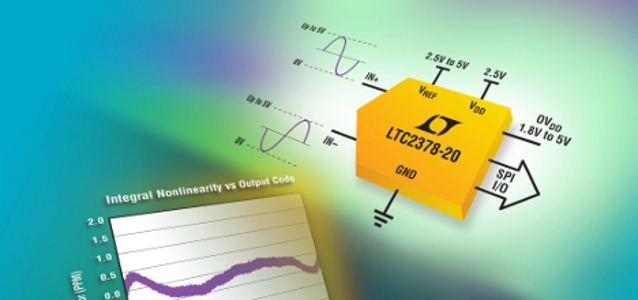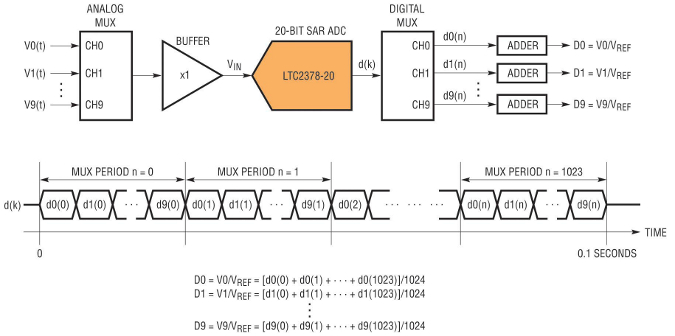
© Linear Technology
General |
[chapter-index=Index Head link-to=24697,24696,24695]Here you find links to the other parts of the application note.[/chapter-index]Accuracy and Speed The LTC2378-20 achieves a level of accuracy previously available only with much slower ADC architectures, such as delta-sigma or multi-slope ADCs. High-channel-count automated test equipment often employs such slow ADC architectures for precision DC measurements, with multiplexers allowing a single meter to service many inputs. The ADC conversion time can often be adjusted over a wide range to trade speed for resolution. However, measurement resolution is often limited to less than 16 bits at sample rates above 100ksps. The LTC2378-20 can take a million readings per second, with 2.3ppm noise resolution (standard deviation of noise, 104 dB SNR) of each reading. Results from multiple readings of the same analog signal may be combined digitally to improve the noise resolution, yielding performance exceeding that of multi-slope ADCs. For example, by averaging blocks of 10 samples, LTC2378-20 effectively operates at 1Msps/10=100ksps with a 0.7ppm noise resolution (114dB SNR). Delta-sigma and multi-slope ADCs may be configured to average an input signal during an observation/integration period to suppress noise and interference. An observation period of 100ms is often used to simultaneously suppress 50Hz and 60Hz line-frequency interference, resulting in a throughput of only 10 samples per second. Accordingly, it takes a full second to service 10 multiplexed channels with one multi-slope ADC. Figure 2 shows a single LTC2378-20 ADC operating at 102.4ksps, configured with a multiplexer circuit to simultaneously measure all 10 signals (interleaved) during the 100ms observation period. While preserving the suppression of line-frequency interference corresponding to the 100ms observation period, the throughput is increased by the factor of multiplexing (here 10, but can be higher), resulting in much higher productivity of the automated test equipment.
In this example, the noise resolution is increased by averaging across 1024 samples taken from each channel during the observation period, providing 22 bits of noise resolution (0.07ppm or 70nV, rms). The averaging operation can be performed with a simple adder that is easy to implement in either programmable logic or in a processor. Thus, the LTC2378-20 enables significant increases in measurement speed, while maintaining the key advantages of prior architectures.
Figure 2 shows a single LTC2378-20 ADC operating at 102.4ksps, configured with a multiplexer circuit to simultaneously measure all 10 signals (interleaved) during the 100ms observation period. While preserving the suppression of line-frequency interference corresponding to the 100ms observation period, the throughput is increased by the factor of multiplexing (here 10, but can be higher), resulting in much higher productivity of the automated test equipment.
In this example, the noise resolution is increased by averaging across 1024 samples taken from each channel during the observation period, providing 22 bits of noise resolution (0.07ppm or 70nV, rms). The averaging operation can be performed with a simple adder that is easy to implement in either programmable logic or in a processor. Thus, the LTC2378-20 enables significant increases in measurement speed, while maintaining the key advantages of prior architectures.
Part 2: Accuracy
Many industrial systems require measurement of critical parameters with extreme accuracy. Examples include seismic monitoring, energy exploration, airflow sensing, and silicon wafer fabrication.
[chapter-index=Index Head link-to=24697,24696,24695]Here you find links to the other parts of the application note.[/chapter-index]Accuracy and Speed The LTC2378-20 achieves a level of accuracy previously available only with much slower ADC architectures, such as delta-sigma or multi-slope ADCs. High-channel-count automated test equipment often employs such slow ADC architectures for precision DC measurements, with multiplexers allowing a single meter to service many inputs. The ADC conversion time can often be adjusted over a wide range to trade speed for resolution. However, measurement resolution is often limited to less than 16 bits at sample rates above 100ksps. The LTC2378-20 can take a million readings per second, with 2.3ppm noise resolution (standard deviation of noise, 104 dB SNR) of each reading. Results from multiple readings of the same analog signal may be combined digitally to improve the noise resolution, yielding performance exceeding that of multi-slope ADCs. For example, by averaging blocks of 10 samples, LTC2378-20 effectively operates at 1Msps/10=100ksps with a 0.7ppm noise resolution (114dB SNR). Delta-sigma and multi-slope ADCs may be configured to average an input signal during an observation/integration period to suppress noise and interference. An observation period of 100ms is often used to simultaneously suppress 50Hz and 60Hz line-frequency interference, resulting in a throughput of only 10 samples per second. Accordingly, it takes a full second to service 10 multiplexed channels with one multi-slope ADC.
 Figure 2 shows a single LTC2378-20 ADC operating at 102.4ksps, configured with a multiplexer circuit to simultaneously measure all 10 signals (interleaved) during the 100ms observation period. While preserving the suppression of line-frequency interference corresponding to the 100ms observation period, the throughput is increased by the factor of multiplexing (here 10, but can be higher), resulting in much higher productivity of the automated test equipment.
In this example, the noise resolution is increased by averaging across 1024 samples taken from each channel during the observation period, providing 22 bits of noise resolution (0.07ppm or 70nV, rms). The averaging operation can be performed with a simple adder that is easy to implement in either programmable logic or in a processor. Thus, the LTC2378-20 enables significant increases in measurement speed, while maintaining the key advantages of prior architectures.
Figure 2 shows a single LTC2378-20 ADC operating at 102.4ksps, configured with a multiplexer circuit to simultaneously measure all 10 signals (interleaved) during the 100ms observation period. While preserving the suppression of line-frequency interference corresponding to the 100ms observation period, the throughput is increased by the factor of multiplexing (here 10, but can be higher), resulting in much higher productivity of the automated test equipment.
In this example, the noise resolution is increased by averaging across 1024 samples taken from each channel during the observation period, providing 22 bits of noise resolution (0.07ppm or 70nV, rms). The averaging operation can be performed with a simple adder that is easy to implement in either programmable logic or in a processor. Thus, the LTC2378-20 enables significant increases in measurement speed, while maintaining the key advantages of prior architectures.
EDITOR'S NOTE_ Don't forget the links to part 1 and 3 of the application note. You find them in the small box at the top right corner of the article.Because a single LTC2378-20 device can potentially replace several discrete components required for a multi-slope design, a valuable degree of design freedom opens up for balancing cost, board space, and channel count. Replacing a multiplexed meter with one or more LTC2378-20 ADCs can shrink system size, lower power, reduce solution cost, and increase speed by orders of magnitude over traditional approaches. Furthermore, because the device can operate in its native mode as a Nyquist ADC at up to 1Msps, a single LTC2378-20 ADC is ideal for use in systems that otherwise would require more than one type of ADC, such as a multi-slope ADC for high-accuracy low-noise measurements and a SAR ADC for faster lower-resolution measurements. ----- Graphics: © Linear Technology Corporation






